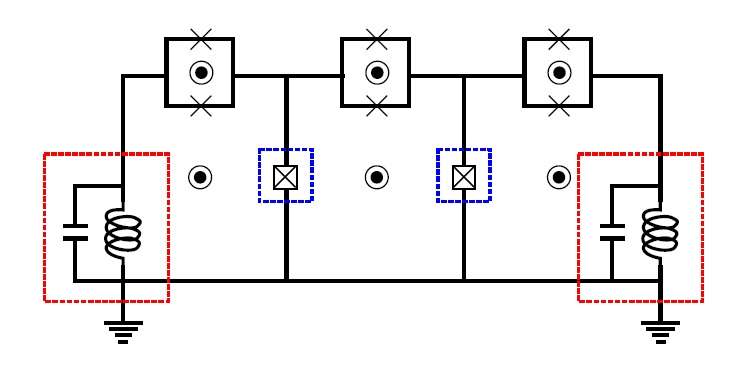April 29, 2016 feature
Autonomous quantum error correction method greatly increases qubit coherence times

(Phys.org)—It might be said that the most difficult part of building a quantum computer is not figuring out how to make it compute, but rather finding a way to deal with all of the errors that it inevitably makes. Errors arise because of the constant interaction between the qubits and their environment, which can result in photon loss, which in turn causes the qubits to randomly flip to an incorrect state.
In order to flip the qubits back to their correct states, physicists have been developing an assortment of quantum error correction techniques. Most of them work by repeatedly making measurements on the system to detect errors and then correct the errors before they can proliferate. These approaches typically have a very large overhead, where a large portion of the computing power goes to correcting errors.
In a new paper published in Physical Review Letters, Eliot Kapit, an assistant professor of physics at Tulane University in New Orleans, has proposed a different approach to quantum error correction. His method takes advantage of a recently discovered unexpected benefit of quantum noise: when carefully tuned, quantum noise can actually protect qubits against unwanted noise. Rather than actively measuring the system, the new method passively and autonomously suppresses and corrects errors, using relatively simple devices and relatively little computing power.
"The most interesting thing about my work is that it shows just how simple and small a fully error corrected quantum circuit can be, which is why I call the device the 'Very Small Logical Qubit,'" Kapit told Phys.org. "Also, the error correction is fully passive—unwanted error states are quickly repaired by engineered dissipation, without the need for an external computer to watch the circuit and make decisions. While this paper is a theoretical blueprint, it can be built with current technology and doesn't require any new insights to make it a reality."
The new passive error correction circuit consists of just two primary qubits, in contrast to the 10 or more qubits required in most active approaches. The two qubits are coupled to each other, and each one is also coupled to a "lossy" object, such as a resonator, that experiences photon loss.
"In the absence of any errors, there are a pair of oscillating photon configurations that are the 'good' logical states of the device, and they oscillate at a fixed frequency based on the circuit parameters," Kapit explained. "However, like all qubits, the qubits in the circuit are not perfect and will slowly leak photons into the environment. When a photon randomly escapes from the circuit, the oscillation is broken, at which point a second, passive error correction circuit kicks in and quickly inserts two photons, one which restores the lost photon and reconstructs the oscillating logical state, and the other is dumped to a lossy circuit element and quickly leaks back out of the system. The combination of careful tuning of the resonant frequencies of the circuit and adding photons two at a time to correct losses ensures that the passive error correction circuit can operate continuously but won't do anything to the two good qubits unless their oscillation has been broken by a photon loss."
The new method can correct photon loss errors at rates up to 10 times faster than those achieved by active, measurement-based methods. In addition, the passive method can partially suppress noise, so that there are fewer errors in the first place. In its current version, the method can correct only one error at a time, so if a second photon loss occurs before the correction is complete, the method cannot fix the resulting error.
All of this error correction leads to a significant increase in the qubit coherence time. The new method can improve this time by a factor of 40 or more compared to without any error correction, and this improvement is greatly needed in order to construct quantum computers. As Kapit explains, qubit coherence times are currently so short that millions of qubits would be required to build a useful quantum computer. Increasing the coherence times can reduce this number to something more feasible.
In the future, Kapit plans to integrate the new passive method with active, measurement-based methods to create a hybrid quantum error correction strategy, and investigate how the two methods might work together.
He is also currently working with an experimental team to try to build, test, and optimize the device in the next few years.
More information: Eliot Kapit. "Hardware-Efficient and Fully Autonomous Quantum Error Correction in Superconducting Circuits." Physical Review Letters. DOI: 10.1103/PhysRevLett.116.150501
Journal information: Physical Review Letters
© 2016 Phys.org




















